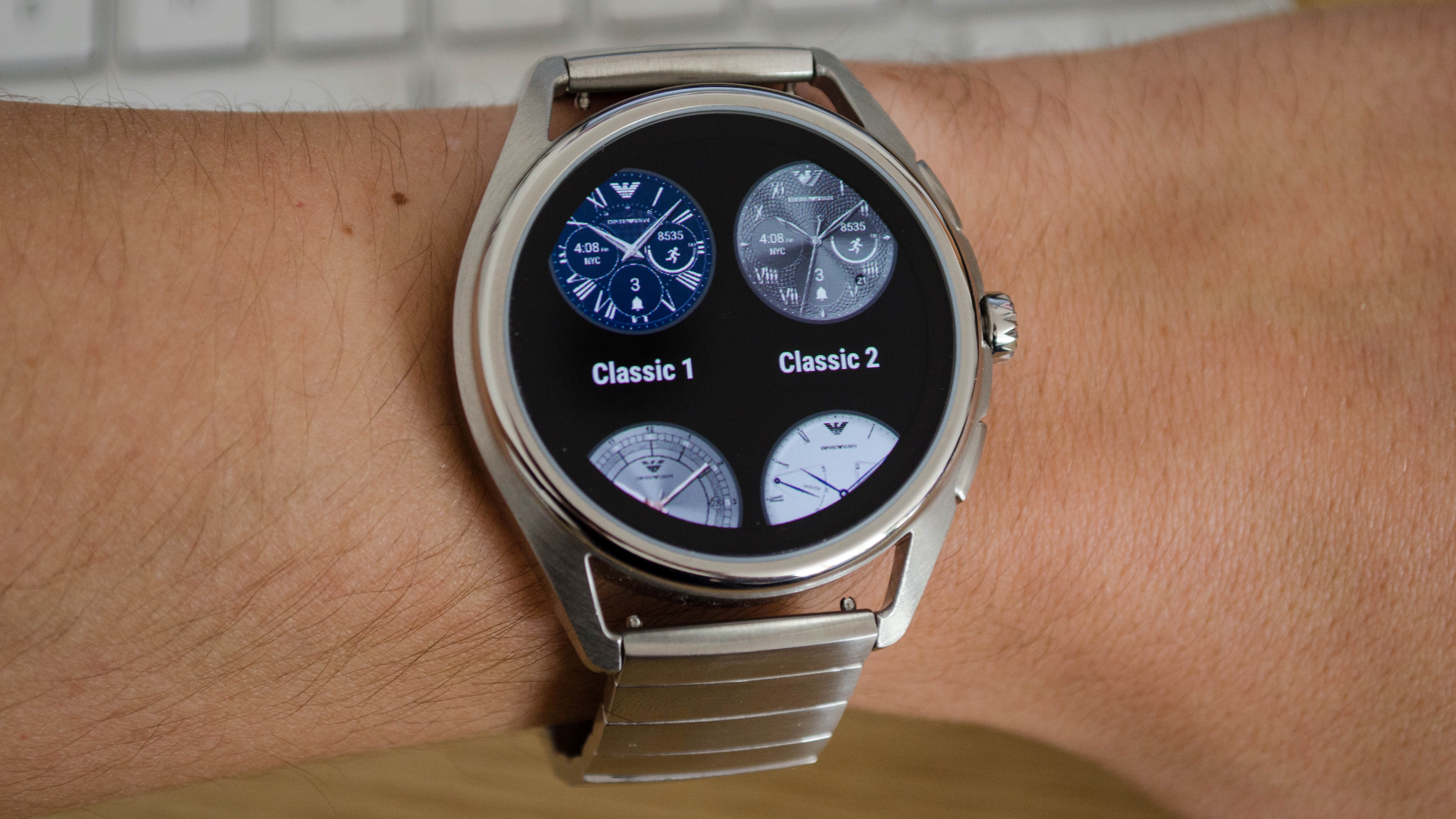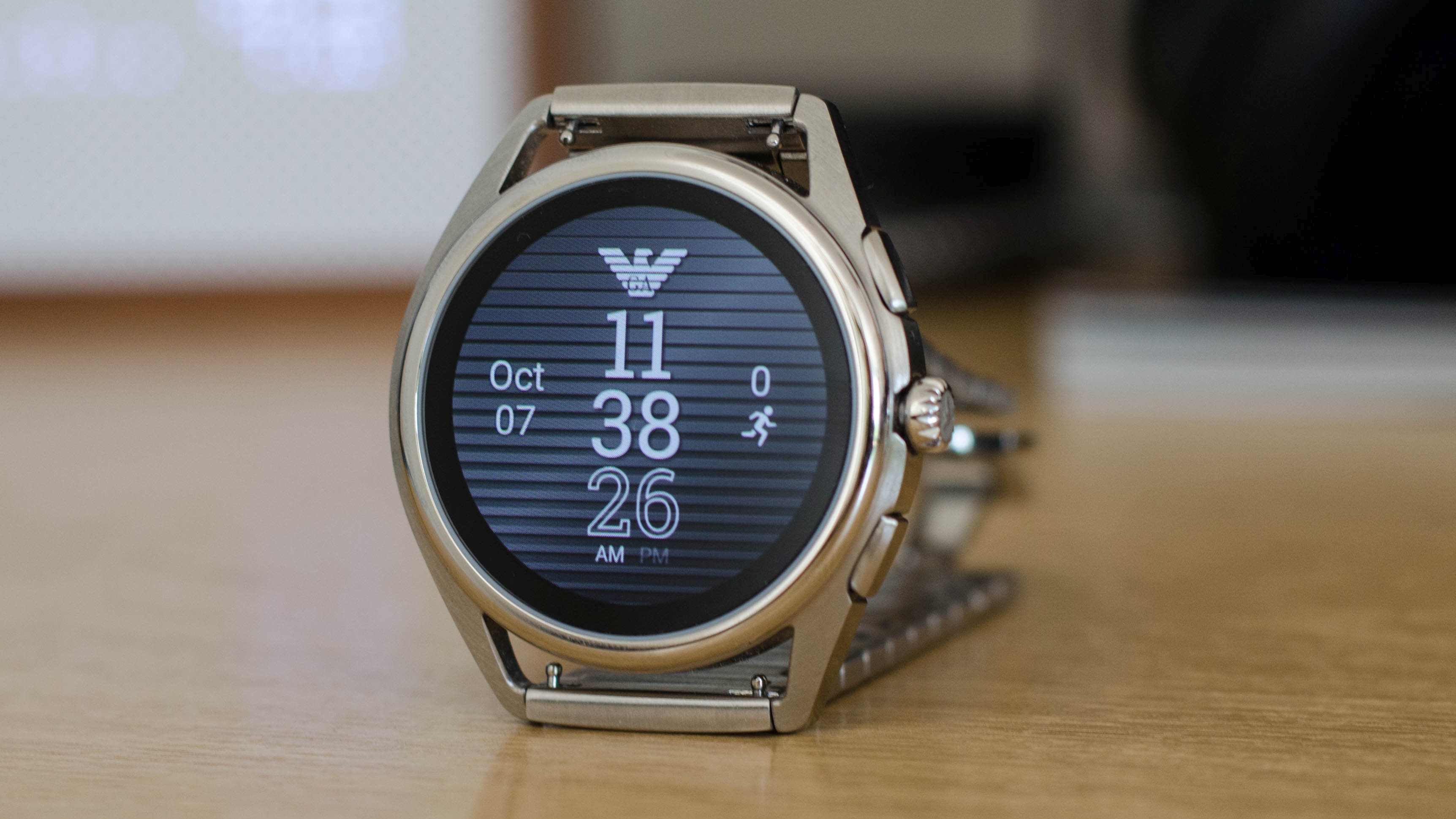Why you can trust TechRadar
Specs, features, interface and performance
- GPS, NFC and wireless charging
- Wide range of customizable faces
- Rotating crown is a neat way to interact with Wear OS
- Chipset is from early 2016, and it shows
Our first few days with the Emporio Armani Connected 2018 did not fill us with confidence. The software felt slow and buggy, with the user interface jumping around jarringly as we pressed the watch’s three buttons to work out what everything did.
We were also confused by the ‘Featured Looks’ screen, which offers up a list of colors (of watch faces, we presumed), but tapping on any produces the message: “You don’t have any styles saved. Start customizing.” It wasn’t at all clear what this meant.
Add this to middling performance and the occasional system crash, and we were starting to wonder if the Armani was a classic case of style over substance.

But then Google’s new Wear OS update arrived in early October, and the situation improved. Weirdly, the version number is still Wear 2.0, but there are significant changes to how the system works.
Watch faces are now modified with a long press of the face you’re currently using; settings like airplane mode and battery saver mode (plus access to Google Pay) are found by swiping down from the home screen to reveal the Quick Settings page.
Swiping up reveals your recent notifications, swiping left to right opens the Google Assistant, and right to left opens Google Fit. It’s a much-improved layout which makes Wear OS devices like this Emporio Armani Connected 2018 easier and simpler to use.

Performance also feels like it has been improved with the update, but there are still occasions when it feels like the watch is being pushed to its limit while doing fairly mundane things - like personalizing the complications of a watch face.
That said, the Armani offers a wide range of varied and unique faces to pick from, giving you the ability to make the watch look truly unique.
Pressing the four o’clock button to open Google Assistant sometimes failed to work, until a second or third press then caused the software to catch up, launching us straight into a training session we accidentally started. Technological glitches like this, on a premium-priced device sporting a reputable name, are frustrating.

These shortfalls are almost certainly to do with the Connected’s chipset, the Qualcomm Snapdragon Wear 2100 which launched way back in February 2016.
This system-on-a-chip was finally replaced by the Wear 3100 in September 2018, but that means the Emporio Armani Connected 2018 - a new smartwatch which has only just gone on sale - has to make do with the dated 2100.
All of that said, once you have the watch setup the way you want, with a face that is perfectly customized, it all runs smoothly enough.

Notifications come through just fine, Google Fit records your walking, running, heart rate and exercise, and media playback works as expected; but knowing the watch can occasionally stumble is enough to remind you of the hardware’s inherent limitations.
What we do like, however, is the rotating crown. It is very nicely weighted (slightly firmer to rotate than the Apple Watch 4’s Digital Crown), and is satisfying to use when scrolling through notifications or your list of installed applications. You can of course just swipe at the screen instead, but using the crown ensures the screen stays fingerprint-free.
Other welcome features include NFC for making contactless payments with Google Pay (something the original Emporio Armani Connected missed out on), and GPS, which we’ll cover in the next section.

Health and fitness
- Heart rate monitor
- Google Fit records huge range of sports and exercises
- GPS means you can leave your phone at home
As we alluded to earlier, it is a strange move from Emporio Armani to fill a fashion watch like the Connected 2018 with fitness-focused features like GPS and a heart rate monitor - not that we are complaining.
Combined with Google Fit, the heart rate monitor takes multiple readings throughout the day and plots these on a chart (viewable on the watch and companion smartphone app, for iOS and Android), then takes a constant reading while you exercise.
Google recently launched a major update for Fit, which moves the focus from counting steps and distance to closing rings - just like on the Apple Watch and other smartwatches.

Two rings represent two daily goals, called ‘move minutes’ and ‘heart points’. The former takes into account general movement as well as steps, while the latter encourages you to raise your heart rate, but this doesn’t necessarily mean you have to hit the gym hard every day to reach your goal.
The aim of the new Google Fit is to reward a lifestyle that is generally healthy, rather than only dish out points and prizes when you lace up your trainers and set a new 10k record.

Exercise is recorded automatically, but if you’re going to do something specific - like weight lifting, or a certain sport, like badminton, football or rock climbing, then you can pick the right activity before you get started.
The list of activities offered up by Google Fit is vast, from the more common sports and gym work to yoga, golf, frisbee, horse riding, and even other activities like gardening, and flossing (ask a teenager).
Integrated GPS means the watch knows its location without needing to ask your smartphone, so you can leave your phone at home and still have accurate location data for any runs or walks you log through Google Fit.
Sleep tracking is not offered by default, but there are numerous third-party apps which can be installed to track your sleep time and quality each night.
Current page: Specs, features, interface and fitness
Prev Page Introduction, design and display Next Page Battery life and verdictAlistair Charlton is based in London and has worked as a freelance technology and automotive journalist for over a decade. A lifelong tech enthusiast, Alistair has written extensively about dash cams and robotic vacuum cleaners for TechRadar, among other products. As well as TechRadar, he also writes for Wired, T3, Forbes, The Independent, Digital Camera World and Grand Designs Magazine, among others.

